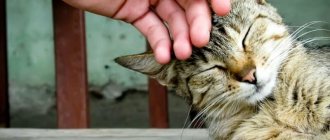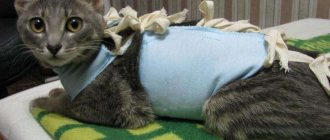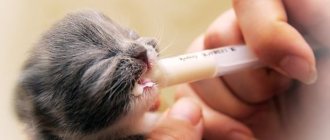How dangerous is a cat bite for humans?
A cat's mouth contains bacteria that do not harm the pet just because air enters the mouth. But if microbes enter an airless environment, they will be able to actively reproduce. Such bacteria are called anaerobes, that is, they live in airless space.
This occurs when the wound opening is small and deep, especially if the interphalangeal joints of the hands are affected. Wounds take a long time to heal, leaving rough scars.
The bite site swells, turns red, edema and suppuration develop. Pasteurella that live in the mouths of cats enter into a symbiotic relationship with streptococci and staphylococci that live on human skin and enhance each other’s effects.
The tendons and bones become inflamed, and the motor functions of the joints are impaired. Microflora spreads throughout the body and causes inflammation of the heart valves. Sepsis may develop.
The most dangerous infections for humans are those transmitted by cat bites:
- Rabies is the most dangerous infection that an unvaccinated cat can infect a person with. The virus is in saliva. Therefore, when a cat bites through skin unprotected by clothing, the infection enters the bloodstream, penetrates the nerve endings and rushes to the brain. If treatment with anti-rabies vaccinations is not started, the victim will die. A rabid cat behaves inappropriately, meows hoarsely, and foamy saliva flows from its mouth. However, the rabies virus enters saliva 3-5 days before the onset of clinical symptoms.
- Tetanus - cats suffering from this disease are characterized by impaired coordination of movements and muscle cramps. Such cases occur rarely, but the risk of infection cannot be ruled out. In humans, tetanus manifests itself as swelling at the site of infection, local lymphadenitis, and convulsions. You need to see a doctor who will prescribe treatment.
- Chlamydia is a disease characterized by discharge from the nose and eyes and high fever. The symptoms of the disease are similar in cats and people. The disease is not fatal to humans, but it is fraught with unpleasant sensations.
- Pasteurellosis is a bacterial infection that causes pneumonia, pyelonephritis, inflammation of the joints and brain when secondary microflora - staphylococci and streptococci - are added. In humans, the disease begins with swelling, edema and the appearance of purulent blisters on the skin. Lack of treatment leads to the development of sepsis.
- Staphylococcosis develops when microbes enter from a cat's mouth or human skin. Abscesses and suppurations develop. Cats infected with staphylococci have an unkempt, shabby appearance.
- Streptococcosis is characterized by symptoms characteristic of a sore throat - sore throat and ears, aching bones, and skin rash.
Be sure to read:
A cat is limping on its front leg: what to do, causes, treatment methods, when it is not pathological
Features of the problem
Most often, a person receives dangerous injuries from a dog. Even the tiny size of a cat does not guarantee that the animal is not a carrier of dangerous diseases. Although you will not receive serious injuries, inflammation will quickly appear at the site of the bite.
With its small teeth, a furry friend can cause a fairly large wound and bite through the skin. Bacteria will enter the muscle tissue within a couple of moments. The patient should immediately treat the wound.
Although cat bites may not seem very deep at first glance, the damage can be irreparable. The situation is especially dangerous when the face, neck or area near the joint is swollen. You need to understand that bites may leave wounds. Before disturbing a homeless animal, be very attentive and careful. If you can see that the cat is stressed by your presence, it is better to move away from it.
The consequences are very varied. The lion's share of felines are carriers of dangerous microorganisms that can even harm humans.
Pets are no exception to the rule, although they are less susceptible to viruses. When a person is bitten, a small amount of microbes enters the human body; the immune system can cope with the pathogen on its own.
If the patient’s immunity is not very strong, then he will become infected from the cat. Swelling of an arm or other limb indicates illness. Start treatment immediately!
Pasteurella multocida is the most common microbe that almost all outdoor cats carry. An infected person may develop pasteurellosis. The disease is characterized by general intoxication of the body, inflammation of areas of the skin and subcutaneous tissue, as well as arthritis.
The first sign of the disease is swelling, swelling and inflammation at the wound site. It is best to seek help from specialists.
Lymphoreticulosis is another disease that can be contracted from infected cats that bite or scratch humans. After just a short period of time, the area of skin in the area of the bite begins to turn red.
Most inflammations appear near the lymph nodes. The bitten person develops the following symptoms: fever, headache, body weakness. If not treated promptly, meningitis may develop.
Complications from a cat bite
Sharp teeth can introduce pathogenic bacteria into the thickness of the muscles.
As a result of infection, the following diseases and pathological conditions may occur:
- tetanus;
- rabies;
- pasteurellosis;
- staphylococcosis;
- streptococosis;
- sepsis;
- cellulite;
- abscess;
- phlegmon;
- arthritis;
- cat fever, manifested by fever and headache.
The following diseases contribute to the occurrence of complications:
- immunodeficiency state;
- alcoholism;
- diabetes;
- liver pathologies;
- vascular pathologies.
What is the likelihood of contracting rabies from a cat bite?
The likelihood of contracting rabies from a vaccinated domestic cat is low, but it still exists for the following reasons:
- Cases of rabies have been reported in this area.
- The vaccination expires.
- The vaccine has expired.
- The temperature regime was violated during transportation or storage.
Be sure to read:
What to do if your cat has bald spots on its fur?
If an unfamiliar cat bites in the yard or on the street, the chances of infection increase. It is unknown whether this animal has been vaccinated. Even if the area is rabies-free, the infection can be spread by mice or rats.
A cat can become infected not only from a rodent bite. The mad mouse becomes bolder, is not afraid of the cat and is even ready to attack him. The cat eats the insolent and becomes infected with rabies.
A cat bit me, what should I do?
Any cat, both indoor and outdoor, is capable of biting a person’s hand, especially if it gets angry. What to do if bitten by a domestic cat?
Most often, the consequences of a bite pass quickly enough, even if there was blood at the beginning. But to prevent your hand from swelling after a cat bite, you can do a number of things at home:
- If the skin is damaged, place your hand under cold running water and hold it there for five minutes. This action will wash the wound and relieve pain.
- Use soap, preferably laundry soap, to remove dirt or dust.
- After which the wound must be cauterized with hydrogen peroxide.
- When the bleeding has completely stopped, antibacterial ointment can be applied to the wound.
It is important to know that bleeding in the event of a cat bite is only beneficial, since the cat’s infection comes with the blood.
If, a day after the cat bite, signs of infection appear, your hand is swollen, and your fingers are swollen, you should start taking antibiotics: doxycycline, ciprofloxacin, ceftriaxone. From the above list, only ceftriaxone can be used by pregnant women.
What not to do about cat bites
If you are bitten by a cat, you should not do the following things:
- Stop bleeding by applying pressure to the bite site. The blood must be allowed to flow out, it will wash out the causative agent of the disease. When pinched, the blood stops and the infection remains inside. Anaerobic conditions favorable for reproduction are created for it.
- Apply a thick layer of ointment , and also cover the wound with a band-aid due to the occurrence of an airless environment favorable to pathogenic microbes.
- Pour liberally into the deep wound with iodine or brilliant green . The surface becomes necrotic, and an anaerobic environment is formed inside the wound.
- Self-medicate: antibiotics have no effect on the rabies virus.
- Drink alcohol: it increases the rate of spread of the infectious agent.
- Postponing a visit to the doctor , if symptoms of rabies occur, treatment will no longer help.
First aid and treatment
Simple first aid measures are described in the previous paragraph; they are suitable for cases where the cat was domestic and vaccinated against rabies and other dangerous infections, and the wound is shallow. But not everyone knows what to do if, after a bite, a leg, arm or other part of the body (usually fingers, since cats show aggression when trying to feed or pet them) becomes red and swollen.
If a person has been bitten by a cat, his finger is swollen, but he feels normal, there is no need to call an ambulance, carry out initial treatment and go to the hospital.
First, you need to thoroughly rinse the wound under running water and laundry soap - this will help remove residual cat saliva, as well as partially eliminate infectious agents.
If the finger is swollen, then it should no longer be treated with chlorhexidine, but with more aggressive agents, for example, alcohol or hydrogen peroxide. The latter should stop the bleeding if it is not severe, but in case of prolonged blood loss (longer than 15 minutes), it is necessary to apply a tight bandage and go to the hospital with it. The treated bite should be covered with a sterile napkin; you should not use antibiotics, ointments or powders before contacting a doctor, since to select them you need to know the type of microorganisms that caused the inflammation.
Treatment
The doctor will decide what to do next; for this he will need to examine the injury, assess the condition of the victim, and also take a smear from the wound and blood for analysis. It is advisable to show a doctor a cat whose hand is swollen after a bite, as this can help quickly find out the cause of the inflammation.
If a doctor has examined a cat bite, and the hand is swollen not from infection, but due to edema caused by damage to blood vessels, then the person will be prescribed daily treatment of the wound with solutions of antimicrobial agents (alcohol, miramistin, chlorhexidine) and wearing a sterile bandage, which must be changed every 5– 6 hours.
Compresses with a solution of sea salt will help relieve swelling faster - it will improve the outflow of fluid from the tissues and disinfect the wound.
If the cause of a swollen finger or other part of the body is microorganisms, further actions may be different. In case of an infection that is not life-threatening, the patient will be prescribed antibacterial, antiviral or antifungal agents for external use (ointments, powders, gels, creams), as well as antibiotics or other drugs for oral use. In case of infection with dangerous pathogenic microorganisms, the uncontrolled reproduction of which can cause severe intoxication, tissue damage or even death, the patient will be sent to the ward of the infectious diseases department, and treatment will take place under the supervision of a doctor.











